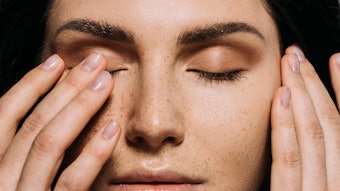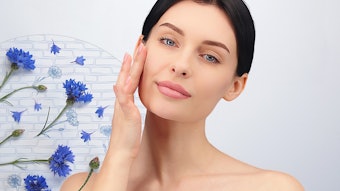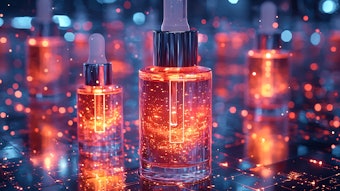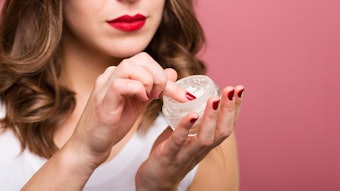To fight the seven signs of aging as outlined by P&G’s recent Olay Total Effects campaign, a formulation must address: lines and wrinkles, loss of firmness, visible pores, uneven skin tone, uneven texture, dullness and dryness. Addressing these signs should start with a vehicle that moisturizes the skin by providing both an emollient film to enhance skin’s natural barrier to water loss, and sufficient humectants to help retain that moisture in skin, to plasticize the stratum corneum (SC). That vehicle’s composition should also optimize the delivery of natural actives from the formula, an expertise exemplified by the late Johann Wiechers, PhD.1
To provide consumers an anti-aging benefit, finished products and ingredients must ameliorate both firmness and lines and wrinkles. The loss of firmness, attributed primarily to the loss of underlying dermal support, is both a sign of skin aging and a cause of most lines and wrinkles. Thus, improving this underlying matrix to enhance skin’s appearance should be a key feature of anti-aging product performance.
A few databases and compendia are helpful in researching botanicals and phytochemicals for new leads and claims substantiation.2-4 For example, the International Cosmetic Ingredient Dictionary & Handbook, 14th Edition, lists more than 2,500 plant species as botanicals, with more than 250,000 known vascular plant species in existence. Since the passage of the Dietary Supplement Health and Education Act (DSHEA) S.784 in 1994, use of herbs, botanicals and their constituents as potential dietary supplement products has risen in popularity.5 This acceleration in the research and marketing of botanicals invigorated the personal care segment that previously had relegated botanical extracts to promotional ingredients—where they still remain in many products. However, with increased consumer demand for reducing the appearance of facial aging, phytochemicals and their source plants have gained credibility as skin care actives.
Due to availability and cost, cosmetic formulators are often constrained to use nature-identical chemical compounds in lieu of those sourced from nature. These compounds are designed to be structurally the same as those found in nature, although formulators should verify the primary structure is the same in atomic composition and bond structure. Most vitamins humans consume are also synthetic for reasons of cost and availability, but some natural compounds, such as vitamin C, are unique in that their chirality governs how they interact with the enzymes in the metabolic pathways they impact. The substituent groups on every carbon center, which has four different groups, can be arranged in either a clockwise or counterclockwise direction, with one being stereoisomer-active and the other not. In these cases, “natural-identical” is only half true.
When formulators employ nature-identical materials for a superficial cosmetic effect, stereoisomers are not important since performance depends on the action of the primary structure. However, formulators must also look for unwanted solvents, catalysts and unreacted starting materials/side products in synthetic chemicals, as these can have undesireable effects. The chemist has many sophisticated analytical tools to gauge nature-identical materials for their purity and semblance to nature. This technical support provides the formulator with confidence that their chemical will perform as nature intended. This column will review well-known natural and nature-identical anti-aging skin care actives and introduce some botanically derived actives.
Natural and Nature-identical Anti-aging Actives
Alpha-hydroxy acids (AHAs): Glycolic, lactic and higher sugar acids all have natural sources (sugar cane, fermentation byproducts, etc.), although some commercial materials are synthetic. The U.S. Food and Drug Administration (FDA) has issued guidelines per the recommendations of the Cosmetic Ingredient Review (CIR) to ensure that irritation does not result from the exfoliant activity of AHAs, which accelerates skin turnover for smoother skin with less fine lines. These limits for safety are a maximum use level of 10% and minimum pH of 3.5, understanding there are variations in minimum use levels for efficacy and maximum pH levels to maintain delivery as an acid based on a given formulation.6–7
Vitamin A: The retinyl family is present in skin care most often as retinol and its esters. In the 1980s, the discovery that retinoic acid in acne treatments improved the appearance of photoaged skin propelled this class of compounds into antiaging treatments. Considering safety and efficacy, controversy surrounds which variety of vitamin A to use, and retinoic acids and synthetic retinoids are not approved for cosmetic applications.
Retinol can effectively stimulate cell turnover and increase dermal collagen expression with minimal irritation but after experiencing these effects, many consumers turn to the ester forms—acetate, propionate and palmitate. Since retinoids are liposoluble, labile and subject to oxidation, they are delivered in chassis vehicles such as lipsomes and solubilized concentrates.8
The carotenoid beta-carotene is a precursor of vitamin A, and this liposoluble active is often used for antioxidant effects. In one study, a strong correlation was found between skin concentration of the carotenoid lycopene and quantified wrinkle density and depth, which was not correlated with the subject’s age. The mechanism was not elucidated.9
Vitamin C: L-ascorbic acid and its derivatives form another large family of natural actives, although most derive from synthetic sources. This chiral vitamin acts as a water-soluble antioxidant and as a cofactor in post-translational hydroxylase enzymes necessary to stabilize collagen in the dermis. The delivery of vitamin C serves these two critical functions to improve the appearance of photoaged skin, reduce the appearance of fine lines and increase skin firmness.8, 10–11 An added effect is the inhibition of melanin expression, presumably by an anti-tyrosinase activity.
Vitamin C is considered a quasi drug in Japan for hyperpigmentary disorders.12 Ascorbic acid is known to be unstable in solution and oxidizes to complex brown compounds in finished products, sometimes reduced with reducing agents such as bisulfites. Alternatively, esters and glycosides with improved oxidative stability are useda, b.
Panthenol: This chiral vitamin precursor is available as the synthetic DL mixture and as the resolved enantiomer dexpanthenol, it is a clear, water-white syrup. The biologically active dexpanthenol converts to pantothenic acid (vitamin B5), which incorporates into coenzyme A, the cofactor in cellular energy processes. Panthenol improves the appearance of skin aging by soothing, moisturizing and improving skin repair. Panthenol is freely water-soluble and with its amide, is susceptible to hydrolysis at high and very low pHs.8
Allantoin: Another traditional cosmetic active, allantoin supports the natural regeneration of the skin. It occurs in Symphytum officinale (comfrey) roots or Scorzonera hispanica (black salsify) roots, up to 0.8% dry weight, but the commercial material is synthetic. With low water-solubility, about 0.5%, it is usually used at lower percentages, although its OTC skin protectant dosage is 0.5–2.0%.13 It can also potentially soothe skin.
Salicylic acid: Salicylic acid is sometimes referred to as a beta hydroxy acid, although that beta carbon is on an aromatic ring, giving it more of a phenol functionality. Salicylic acid has potential antioxidant activity, leading to an anti-inflammatory effect in addition to its keratolytic and antimicrobial functionalities.14 It is available as a natural extractc or as a synthetic chemical. As a free acid in mead-owsweet, senna leaves and chamomile blossoms, salicylic acid and its salts can be considered preservatives, according to NaTrue.15 This versatile active is approved for OTC scrub products for anti-acne and anti-dandruff benefits according to the FDA, and its salts and esters demonstrate topical analgesic effects and sunscreen activity.
Botanical Anti-inflammatory and Antioxidant Actives
Botanical anti-inflammatories are addressed here, as inflammation is one of the primary causes of skin aging.16–17 This “inflamm-aging”18 wreaks havoc on all biological systems including the skin through the release by immune cells of free radical chemicals and matrix metalloproteinases (MMPs). This process, mediated by the release of inflammatory cytokines in the epidermis, is stimulated by a variety of environmental insults including UV radiation and pollutants.19 This link between antioxidant and antiinflammatory activities goes hand in hand for many phytochemical actives.
Epigallocatechins: Green tea polyphenols, such as the epigallocatechins (EGCs), exhibit both anti-inflammatory and antioxidant properties. EGCs and various tea extracts have been shown to suppress the formation of advanced glycation end products (AGEs)-also culprits in skin aging.20 A number of other phenolic phytochemicals such as resveratrol, curcumin, quercitin and ferulic acid, may exhibit similar activity.
Carthaginian berry: A dry extract of pericarp from pomegranated contains high levels of polyphenols, including ellagic acid derivatives. These exhibit antioxidant and anti-inflammmatory activities. In vitro studies demonstrated reduced proinflammatory cytokines and significant antioxidant activity by these phytochemicals.
Dragon’s Blood: A resin extract of Croton lechlerie with reported antiinflammatory action originates from traditional medicine of the indigenous tribes in South America. Derived from the Euphorbiaceae family, this extract exhibits activity due to a mix of proanthocyanidin polyphenols and the unusual tertiary amine alkaloid taspine.
Kinetin: Kinetinf is a type of cytokinin, a class of plant hormones that promotes cell division. Furfuryladenine identifies the chemistry of kinetin that appears to be derived from the breakdown products of nucleic acids. Kinetin is claimed to have antioxidant properties and is promoted to enhance collagen synthesis.21
Echinacea: Echinacea purpureag contains high levels of cichoric acid, a symmetrical hydroxycinnamic acid derivative that has antioxidant properties and reportedly stimulates hyaluronate production to enhance the firmness of skin.22
Gotu kola: Centella asiatica (gotu kola) extract has found utility as a cosmetic botanical for many years, and more purified and fractionated variants are currently promoted for their activity through two mechanisms. This extract contains triterpinoid glycosides or saponin compounds such as asiaticoside and madecassoside, and their aglycones stimulate collagen synthesis to improve skin firmness and reduce wrinkles. These are fortified with a complex of polyphenols that contributes antioxidant and antiinflammatory action.
Scytonemin: Scytonemin is a blue-algae pigment that has antiinflammatory as well as strong UV attenuating properties. It has appeared in academic literature for decades but has yet to be commercialized, possibly due to its dark color.23
Natural Peptides for Anti-aging
There is great potential for protein and amino acid materials in natural anti-aging cosmetics. For at least a few decades, the implementation of synthetic peptides as skin care actives has influenced the industry. Although some can be identified as nature-identical and naturally derived, i.e., the dipeptide carnosine and its derivatives and dipalmitoyl hydroxyproline, most are synthetic. Creators of actives might benefit by looking to natural proteins and small protein fragments that have biological activity through enzymatic hydrolysis and fractionation.24
For example, one hydrolyzed milk proteinh composed mostly of tripeptides has been found to moisturize and stimulate collagen and cell proliferation, thereby reducing fine lines and wrinkles. Also, a whey proteinj consisting of the bioactive fraction of natural polypeptides from milk claims to have anti-inflammatory properties and to increase collagen and hyaluronic acid synthesis.
Conclusion
The cosmetic industry has only skimmed the surface of the natural actives that will eventually be available. From the simple, yet effective natural moisturizers like glycerin, sodium pyrrolidone carboxylic acid (PCA) and other amino acids and their polymers, such as polyglutamic acid (PGA); to natural lipid emollients like shea butter that provide a protective film to enhance skin’s natural barrier; to the yet undiscovered bioactive compounds in the plant kingdom, the industry can look forward to a continuing stream of innovative natural actives in the future.
References
Send e-mail to [email protected].
- JW Wiechers, CL Kelly, TG Blease and JC Dederen, Formulating for efficacy, Cosm & Toil 119(3) (2004)
- J Duke, Dr. Duke’s Phytochemical and Ethnobotanical Databases, www.ars-grin.gov/duke (Accessed Mar 26, 2013)
- T Fleming et al, Physician’s Desk Reference for Herbal Medicines, First edition, Medical Economics Company, NJ USA (1998)
- T Johnson, CRC Ethnobotany Desk Reference, CRC Press, Boca Raton, FL USA (1999)
- Commission on Dietary Supplement Labels– Executive Summary, www.health.gov/dietsupp/ execsum.htm (Accessed Mar 26, 2013)
- Alpha Hydroxy Acids in Cosmetics, U.S. Food and Drug Administration, www.fda. gov/Cosmetics/ProductandIngredientSafety/ SelectedCosmeticIngredients/UCM107940 (Accessed Mar 14, 2014)
- Guidance: Labeling for Cosmetics Containing Alpha Hydroxy Acids, U.S. Food and Drug Administration, www.fda.gov/ Cosmetics/GuidanceComplianceRegulatoryInformation/ GuidanceDocuments/ucm090816. htm (Accessed Mar 14, 2014)
- D Chernasov, Design and development of anti-aging formulations, ch 12 in Skin Aging Handbook, N Dyan, ed, William Andrew, Inc., Norwich, NY USA (2008) pp 298–301
- ME Darvin, Non-invasive measurements of the kinetics of carotenoid antioxidant substances in the skin, doctoral thesis, Universitätsmedizin Charite-Berlin (2007)
- N Wilson, Market evolution of anti-aging treatments, ch 2 in Skin Aging Handbook, N Dyan, ed, William Andrew Inc., Norwich, NY USA (2008) pp 15–34
- KE Burke, Prevention and treatment of aging skin with topical antioxidants, ch 8 in Skin Aging Handbook, N Dyan, ed, William Andrew Inc., Norwich, NY USA (2008)
- H Ando et al, Quasi-drugs developed in Japan for the prevention or treatment of hyperpigmentary disorders, Int J Mol Sci 11(6) 2566–2575 (2010)
- FDA OTC Skin Protectant Products Final Monograph, Drug Federal Register 68(107) Rules and Regulations 33377 (Jun 4, 2003)
- D Fernandes, Evolution of cosmeceuticals and their application to skin disorders, including aging and blemishes, ch 4 in Dermatologic, Cosmeceutic, and Cosmetic Development. Therapeutic and Novel Approaches, HA Walters and MS Roberts, eds, Informa Healthcare USA, Inc, New York (2008)
- Annex 2a: Nature-identical preservatives approved for the production of natural cosmetics, NaTrue, www.natrue.org/fileadmin/natrue/ downloads/Criteria_English_Version_2.pdf (Accessed Mar 14, 2013)
- CK Angerhofer et al, The use of natural compounds and botanicals in the development of anti-aging skin care products, ch 10 in Skin Aging Handbook, N Dayan, ed, William Andrew, Inc., Norwich, NY USA (2008) pp 205–263
- GK Menon et al, Approaches to the development of cosmetic products to counter the effects of skin aging, ch 11 in Skin Aging Handbook, N Dayan, ed, William Andrew, Inc, Norwich, NY USA (2008) pp 265–290
- C Franceschi et al, Inflamm-aging: An evolutionary perspective on immunosenescence, Annals of the New York Academy of Sciences 908, Molecular and Cellular Gerontology pp 244–254 (June 2000)
- GJ Fisher, S Kang, J Varani, Z Bata-Csorgo, Y Wan, S Datta and JJ Voorhees, Mechanisms of photoaging and chronological skin aging, Arch Dermatol 138(11) 1462–1470 (2002)
- N Kinae et al, Suppression of the formation of advanced glycosylation products by tea extracts, ch 7 in Food Phytochemicals for Cancer Prevention II, American Chemical Society pp 68–75 (1994)
- SB Levy, Kinetin, ch 22 in Cosmeceuticals and Active Cosmetics, P Elsner and HI Maibach, eds, Taylor and Francis Group (2005)
- G Mazza and DB Oomah, Herbs, Botanicals and Teas, CRC Press (2000) pp 51
- CS Stevenson et al, Scytonemin-A marine natural product inhibitor of kinases key in hyperproliferative inflammatory diseases, Inflammation Research 51(2) pp 112–114 (2002)
- NF Haard, Enzymatic modification of proteins in food systems, ch 7 in Chemical and Functional Properties of Food Proteins, ZE Sikorski, ed, CRC Press, Boca Raton, FL, USA (2001)










